Split-Voltage Configuration Improves Integrated Amplifier Power-Efficiency
Abstract
1. Introduction
2. Split-Voltage Amplifier Design
3. Measured Results
3.1. Evaluation of the Amplifier Chip
3.2. Earthworm Action Potential
4. Comparison
5. Conclusions
Author Contributions
Funding
Data Availability Statement
Conflicts of Interest
References
- Rieger, R.; Taylor, J. Design Strategies for Multi-Channel Low-Noise Recording Systems. Analog Integr. Circuits Signal Process. 2009, 58, 123–133. [Google Scholar] [CrossRef]
- Leung, L.-F.; Tsui, C.-Y. Energy-Aware Synthesis of Networks-on-Chip Implemented with Voltage Islands. In Proceedings of the 2007 44th ACM/IEEE Design Automation Conference, San Diego, CA, USA, 4–8 June 2007; pp. 128–131. [Google Scholar] [CrossRef]
- Russo, P.; Yengui, F.; Pillonnet, G.; Taupin, S.; Abouchi, N. Switching Optimization for Class-G Audio Amplifiers with Two Power Supplies. Circuits Syst. 2012, 3, 90–98. [Google Scholar] [CrossRef]
- Johnson, B.; Molnar, A. An orthogonal current-reuse amplifier for multi-channel sensing. IEEE J. Solid-State Circuits 2013, 48, 1487–1496. [Google Scholar] [CrossRef]
- Shen, L.; Lu, N.; Sun, N. A 1-V 0.25-μW Inverter Stacking Amplifier with 1.07 Noise Efficiency Factor. IEEE J. Solid-State Circuits 2018, 53, 896–905. [Google Scholar] [CrossRef]
- Simmich, S.; Rieger, R. Analysis of Current-Reuse and Split-Voltage Topology for Biomedical Amplifier Arrays. In Proceedings of the 2022 17th Conference on Ph.D Research in Microelectronics and Electronics (PRIME), Villasimius, Italy, 12–15 June 2022. [Google Scholar] [CrossRef]
- Kim, C.; Jang, A.; Kim, S.; Cho, S.; Lee, D.; Kim, Y.-J. A Wearable ECG Monitoring System Using Microneedle Electrodes for Small Animals. IEEE Sens. J. 2023, 23, 21873–21881. [Google Scholar] [CrossRef]
- Zhang, Y.; Yang, C.; Sun, J.; Li, Z.; Gao, H.; Luo, Y.; Xu, K.; Pan, G.; Zhao, B. A Wireless Headstage System Based on Neural-Recording Chip Featuring 315 nW Kickback-Reduction SAR ADC. IEEE Trans. Biomed. Circuits Syst. 2023, 17, 105–115. [Google Scholar] [CrossRef]
- Chang, Y.; Jang, J.; Cho, J.; Lee, J.; Son, Y.; Park, S.; Kim, C. Seamless Capacitive Body Channel Wireless Power Transmission toward Freely Moving Multiple Animals in an Animal Cage. IEEE Trans. Biomed. Circuits Syst. 2022, 16, 714–725. [Google Scholar] [CrossRef]
- Jia, Y.; Lee, B.; Kong, F.; Zeng, Z.; Connolly, M.; Mahmoudi, B.; Ghovanloo, M. A Software-Defined Radio Receiver for Wireless Recording from Freely Behaving Animals. IEEE Trans. Biomed. Circuits Syst. 2019, 13, 1645–1654. [Google Scholar] [CrossRef]
- Tasneem, N.T.; Biswas, D.K.; Reza, S.; Becker, A.; Mahbub, I. Multichannel Electrophysiological Recording with Spike Detection and Sorting in a Duty-cycled Wireless Optogenetic Headstage. IEEE Sens. J. 2023, 23, 26075–26086. [Google Scholar] [CrossRef]
- Kanchwala, M.A.; McCallum, G.A.; Durand, D.M. A Miniature Wireless Neural Recording System for Chronic Implantation in Freely Moving Animals. In Proceedings of the 2018 IEEE Biomedical Circuits and Systems Conference (BioCAS), Cleveland, OH, USA, 17–19 October 2018; pp. 1–4. [Google Scholar] [CrossRef]
- Sun, J.; Yang, C.; Zhang, Y.; Li, Z.; Gao, H.; Yu, C.; Yu, C.; Luo, Y.; Xu, K.; Pan, G.; et al. Live Demonstration: A BLE Wireless Neural-Recording Headstage on Freely-Moving Rat. In Proceedings of the 2022 IEEE Biomedical Circuits and Systems Conference (BioCAS), Taipei, Taiwan, 13–15 October 2022; p. 244. [Google Scholar] [CrossRef]
- Guo, Y.; Ma, Z.; Sheng, D.; Lei, J.; Zhang, M.; Wang, T.; Sheng, X. A Wireless Neural Interface Device for Simultaneous Optogenetics and Neural Recording. In Proceedings of the 2023 IEEE Biomedical Circuits and Systems Conference (BioCAS), Toronto, ON, Canada, 19–21 October 2023; pp. 1–5. [Google Scholar] [CrossRef]
- Szuts, T.; Fadeyev, V.; Kachiguine, S.; Sher, A.; Grivich, M.V.; Agrochão, M.; Hottowy, P.; Dabrowski, W.; Lubenov, E.V.; Siapas, A.G.; et al. A wireless multi-channel neural amplifier for freely moving animals. Nat. Neurosci. 2011, 14, 263–269. [Google Scholar] [CrossRef]
- Papadopoulou, A.; Hermiz, J.; Grace, C.; Denes, P. A Modular 512-Channel Neural Signal Acquisition ASIC for High-Density 4096 Channel Electrophysiology. Sensors 2024, 24, 3986. [Google Scholar] [CrossRef] [PubMed]
- Simmich, S.; Bahr, A.; Rieger, R. Noise Efficient Integrated Amplifier Designs for Biomedical Applications. Electronics 2021, 10, 1522. [Google Scholar] [CrossRef]
- Rieger, R.; Taylor, J.; Demosthenous, A.; Donaldson, N.; Langlois, P.J. Design of a low-noise preamplifier for nerve cuff electrode recording. IEEE J. Solid-State Circuits 2003, 38, 1373–1379. [Google Scholar] [CrossRef]
- Steyaert, M.S.J.; Sansen, W.M.C. A micropower low-noise monolithic instrumentation amplifier for medical purposes. IEEE J. Solid-State Circuits 1987, 22, 1163–1168. [Google Scholar] [CrossRef]
- Muller, R.; Gambini, S.; Rabaey, J.M. A 0.013 mm2, 5 μW, DC-Coupled Neural Signal Acquisition IC with 0.5 V Supply. IEEE J. Solid-State Circuits 2012, 47, 232–243. [Google Scholar] [CrossRef]
- Shannon, K.M.; Gage, G.J.; Jankovic, A.; Wilson, W.J.; Marzullo, T.C. Portable conduction velocity experiments using earthworms for the college and high school neuroscience teaching laboratory. Adv. Physiol. Educ. 2014, 38, 62–70. [Google Scholar] [CrossRef]
- Rieger, R.; Taylor, J. A Switched-Capacitor Front-End for Velocity-Selective ENG Recording. IEEE Trans. Biomed. Circuits Syst. 2013, 7, 480–488. [Google Scholar] [CrossRef]
- Kim, H.; Kwon, Y.; You, D.; Choi, H.W.; Kim, S.H.; Heo, H.; Kim, C.-Y.; Lee, H.-D.; Ko, H. Low-Noise Chopper Amplifier Using Lateral PNP Input Stage with Automatic Base Current Cancellation. IEEE Trans. Circuits Syst. II Exp. Briefs 2021, 68, 2297–2301. [Google Scholar] [CrossRef]
- Zhang, J.; Zhang, H.; Sun, Q.; Zhang, R. A Low-Noise, Low-Power Amplifier with Current-Reused OTA for ECG Recordings. IEEE Trans. Biomed. Circuits Syst. 2018, 12, 700–708. [Google Scholar] [CrossRef]
- Liu, J.; Allstot, D.J. A Chopper-Stabilized Switched-Capacitor Front-End for Peripheral Nervous System Recording. IEEE Trans. Circuits Syst. I Reg. Papers 2023, 70, 3065–3074. [Google Scholar] [CrossRef]
- Zhou, Z.; Zhu, L.; Yang, R.; Li, J.; Wang, W.; Pan, J.; Liu, M.; Wang, K.; Wang, Z. A High CMRR Instrumentation Amplifier Employing Pseudo-Differential Inverter for Neural Signal Sensing. IEEE Sens. J. 2022, 1, 419–427. [Google Scholar] [CrossRef]
- Livanelioglu, C.; Choi, W.; Kim, D.; Liao, J.; Incandela, R.; Jang, T. A Compact and PVT-Robust Segmented Duty-Cycled Resistor Realizing TΩ Impedances for Neural Recording Interface Circuits. IEEE Solid-State Circuits Lett. 2023, 6, 25–28. [Google Scholar] [CrossRef]
- Lee, B.; Ghovanloo, M. An Adaptive Averaging Low Noise Front-End for Central and Peripheral Nerve Recording. IEEE Trans. Circuits Syst. II Exp. Briefs 2018, 65, 839–843. [Google Scholar] [CrossRef]
- Rezaei, M.; Maghsoudloo, E.; Bories, C.; De Koninck, Y.; Gosselin, B. A Low-Power Current-Reuse Analog Front-End for High-Density Neural Recording Implants. IEEE Trans. Biomed. Circuits Syst. 2018, 12, 271–280. [Google Scholar] [CrossRef] [PubMed]
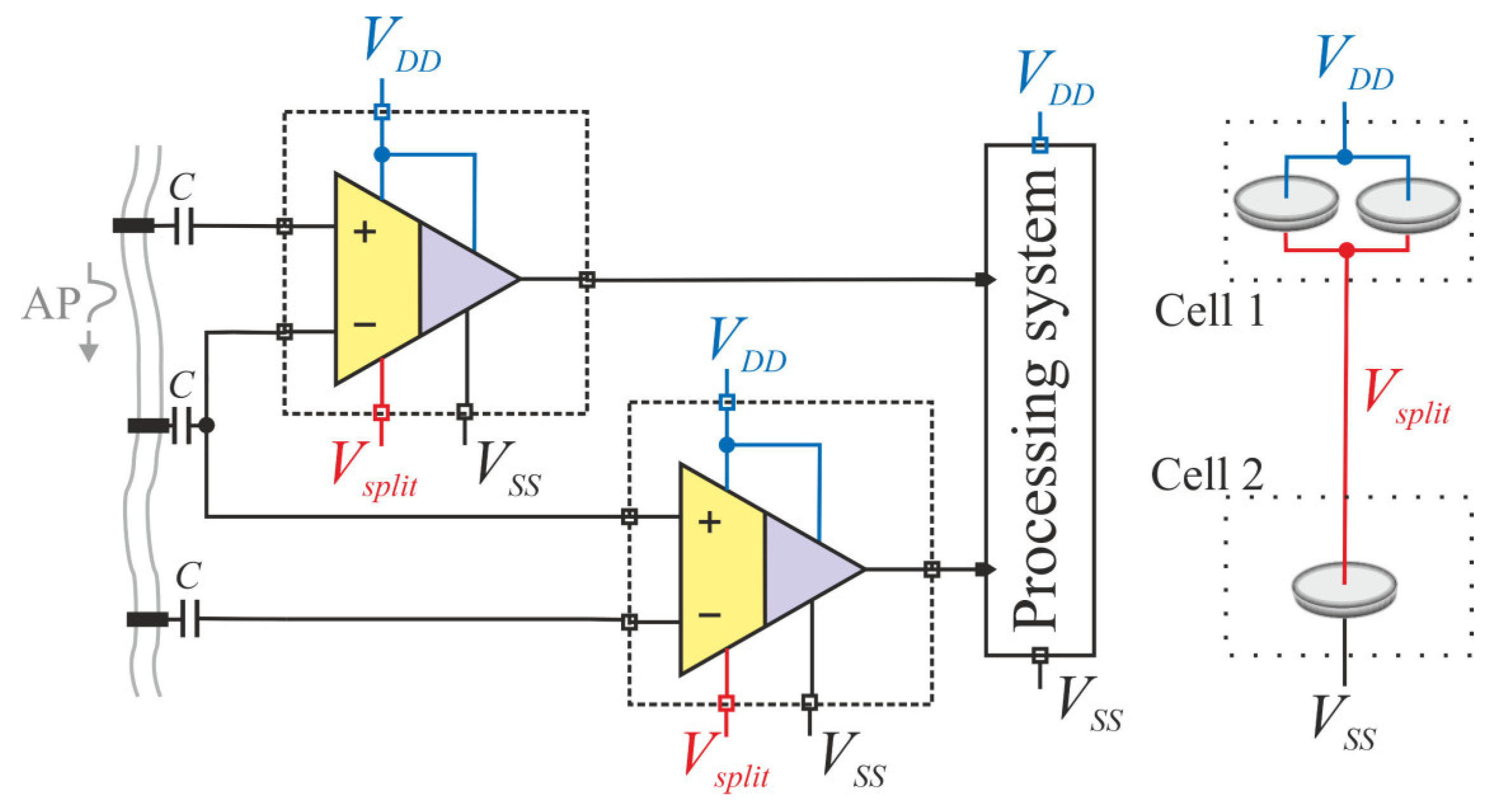


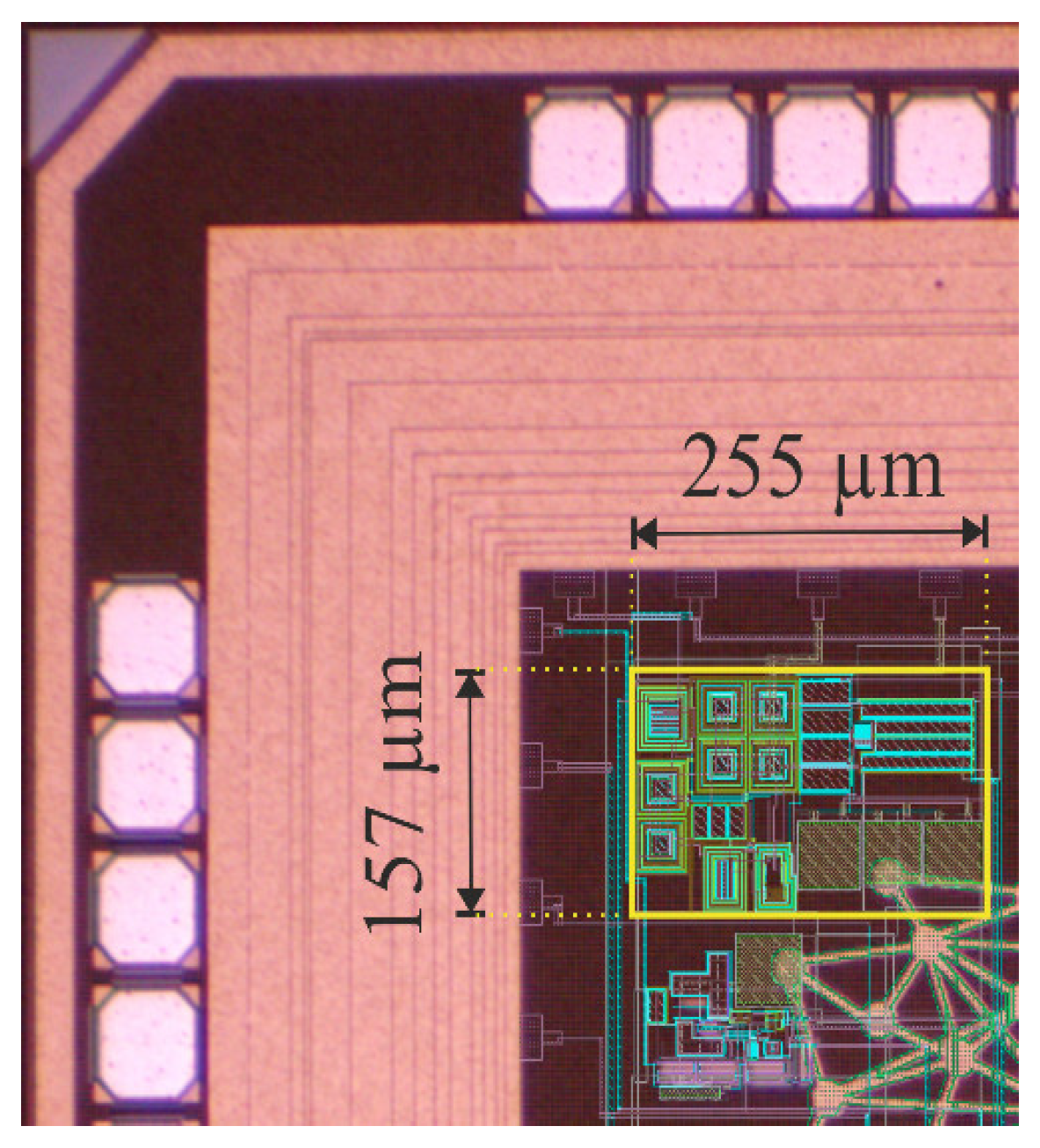
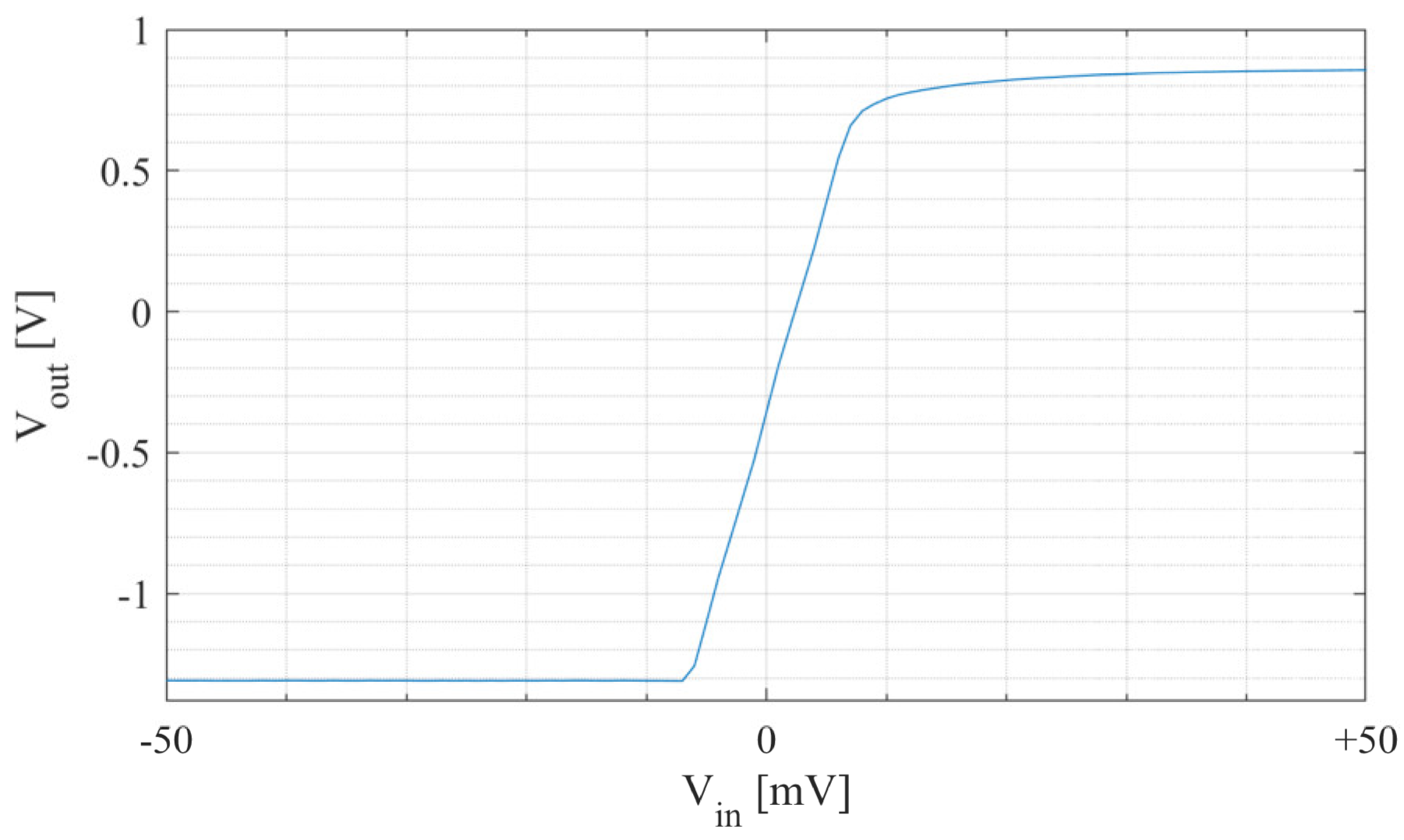

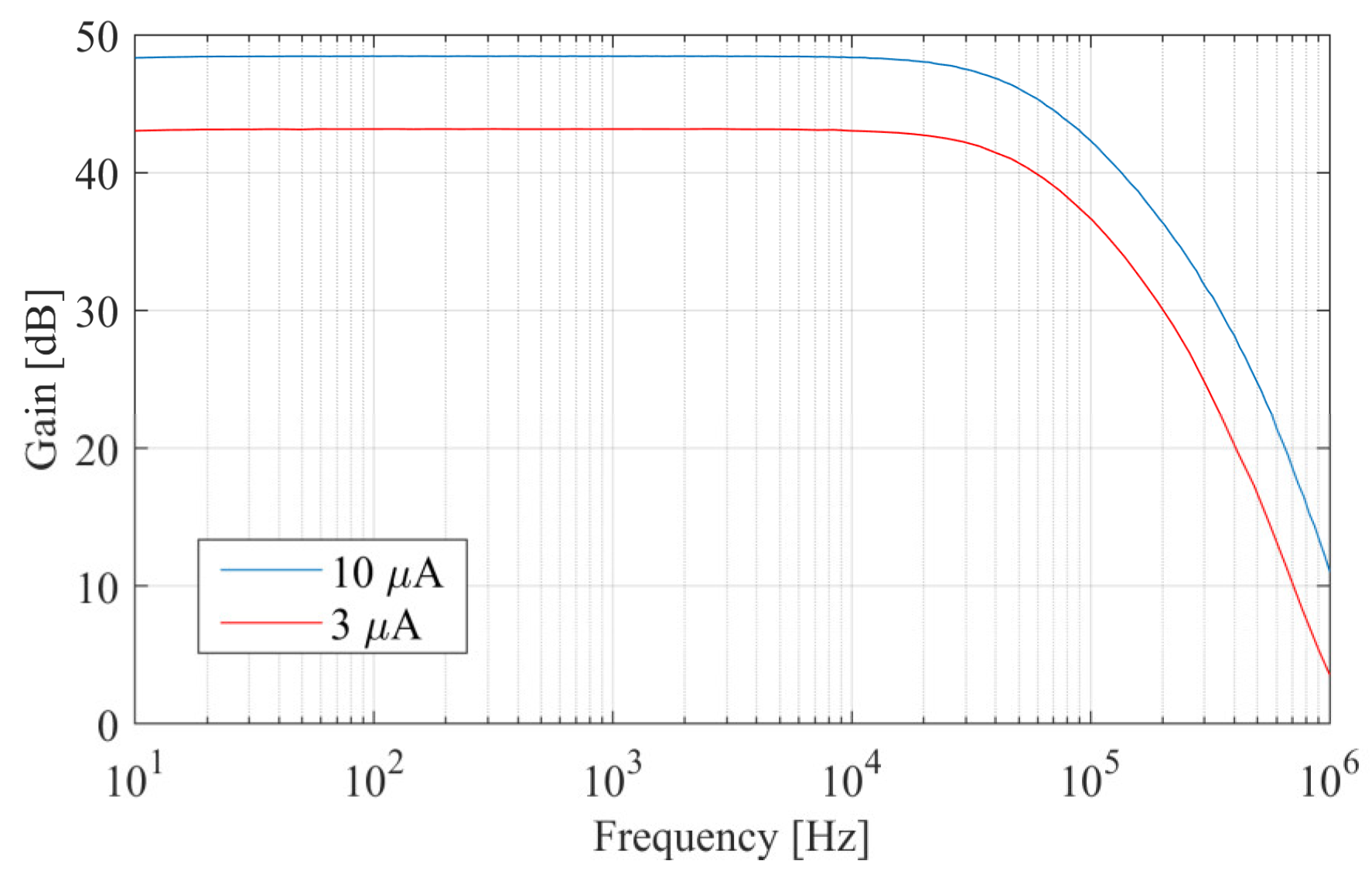


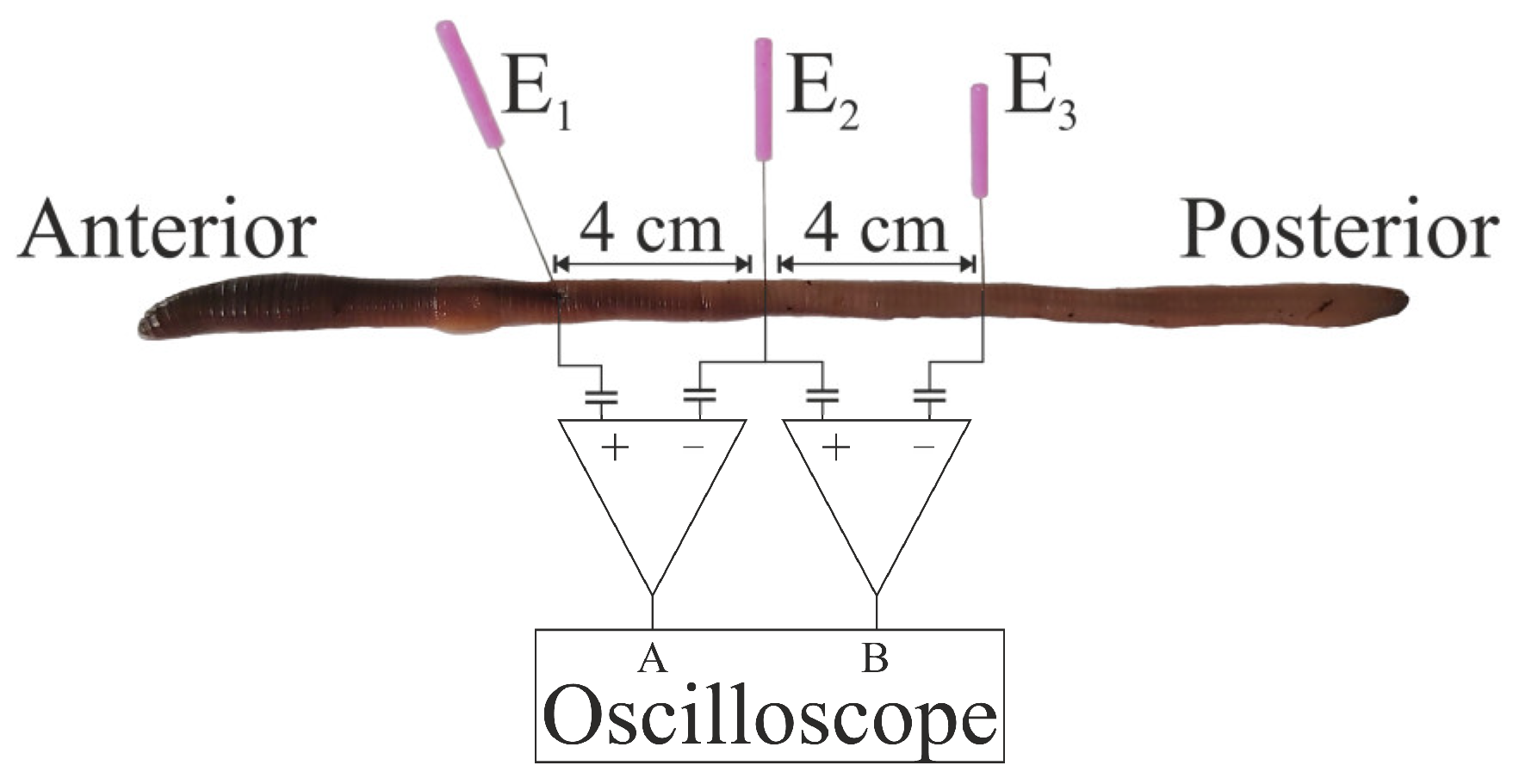

| Device | W/L in µm/µm | Voltages Used in (1), (2), (3) |
|---|---|---|
| Q1, Q2 | 10/10 | VBE = 0.7 V |
| Q3 | 20/20 | - |
| M1 | 20/1 | - |
| M2 | 200/1 | VDS_Mbias2 = 0.038 V |
| M3, M5 | 70/8 | VGS_M3,5 = 0.876 V |
| M4, M6 | 80/8 | - |
| M7, M8 | 50/0.4 | - |
| M9, M10 | 70/15 | - |
| Ibias | 3 µA |
| This Work | TCAS-I ’23 [25] | TBioCAS ’18 [24] | TCAS-II ’21 [23] | Sensors J. ’22 [26] | SSC-L’23 [27] | TCAS-II ’18 [28] | JSSC’18 [5] | TBioCAS ’18 [29] | |
|---|---|---|---|---|---|---|---|---|---|
| Technology [nm] | 350 | 180 | 350 | 180 | 180 | 180 | 180 | 180 | 180 |
| Input transistor | Lat. BJT | CMOS | CMOS | Lat. BJT | CMOS | CMOS | CMOS | CMOS | CMOS |
| Supply voltage [V] | 3 | 1.8 | 2 | 3.3 | 1.8 | 1.8 | 1 | 1 | 1.8 |
| Bandwidth [Hz] | 1–55 k | 170–9680 | 0.2–200 | 0.1–39.2 k | 200–5 k | 0.2–5 k | 20–15 k | 250–10 k | 1–10 k |
| IRN [µVrms] | 0.923 (0.1–10 kHz) | 2.21 (1–100 kHz) | 2.05 (0.1–10 kHz) | - | 3.6 (0.2–5 kHz) | 6.61 (0.2–5 kHz) | 1.8 (10–17 kHz) | 5.5 (0.25–10 kHz) | 3.2 (1–10 kHz) |
| Noisefloor [nV/√Hz] | 7 | 16 | - | 5.53 | 48 | 70 | 10 | 50 | 60 |
| NEF | 2.84 | 3.5 | 2.26 | 3.22 | 4.3 | 5 | 3.5 | 1.07 | 1.94 |
| PEF | 18.3 | 22 | 10.2 | 34.2 | 33.3 | 45 | 12.5 | 1.15 | 6.77 |
| Power [µW] | 152 | 28.98 | 0.320 | 481.8 | 8.3 | 0.97 | 4.4 | 0.25 | 4.5 |
| Area [mm2] | 0.04 | 0.136 | 0.18 | 0.297 | 0.026 | 0.039 | 0.28 | 0.02 | 0.072 |
| Normalized Area | 326.8 k | 4.2 M | 1.46 M | 9.2 M | 802 k | 1.2 M | 8.6 M | 617.3 k | 2.22 M |
| 1/f corner [Hz] | 3 | - | ~ 1 k | 5 | ~1 k | ~2 k | ~8 | 300 | 200 |
Disclaimer/Publisher’s Note: The statements, opinions and data contained in all publications are solely those of the individual author(s) and contributor(s) and not of MDPI and/or the editor(s). MDPI and/or the editor(s) disclaim responsibility for any injury to people or property resulting from any ideas, methods, instructions or products referred to in the content. |
© 2024 by the authors. Licensee MDPI, Basel, Switzerland. This article is an open access article distributed under the terms and conditions of the Creative Commons Attribution (CC BY) license (https://creativecommons.org/licenses/by/4.0/).
Share and Cite
Simmich, S.; Rieger, R. Split-Voltage Configuration Improves Integrated Amplifier Power-Efficiency. J. Low Power Electron. Appl. 2024, 14, 45. https://doi.org/10.3390/jlpea14030045
Simmich S, Rieger R. Split-Voltage Configuration Improves Integrated Amplifier Power-Efficiency. Journal of Low Power Electronics and Applications. 2024; 14(3):45. https://doi.org/10.3390/jlpea14030045
Chicago/Turabian StyleSimmich, Sebastian, and Robert Rieger. 2024. "Split-Voltage Configuration Improves Integrated Amplifier Power-Efficiency" Journal of Low Power Electronics and Applications 14, no. 3: 45. https://doi.org/10.3390/jlpea14030045
APA StyleSimmich, S., & Rieger, R. (2024). Split-Voltage Configuration Improves Integrated Amplifier Power-Efficiency. Journal of Low Power Electronics and Applications, 14(3), 45. https://doi.org/10.3390/jlpea14030045







